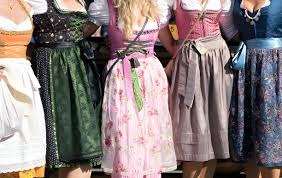The dirndl, a traditional dress with deep roots in Alpine culture, has evolved remarkably over the centuries from a humble folk costume to a prominent fashion statement. Its journey mirrors broader social changes and reflects shifts in both cultural identity and fashion trends.
Origins and Early History
The dirndl originated in the Bavarian and Austrian Alps during the 19th century. Initially, it was a practical garment worn by rural women in the Alpine regions of Germany, Austria, and Switzerland. The term “dirndl” comes from the Bavarian dialect, meaning “little girl” or “young woman,” which points to its origins as a dress for young women and girls. Originally, the dirndl was a simple, functional outfit consisting of a long skirt, a fitted bodice, and a white blouse.
The early dirndl was designed to be practical and durable, reflecting the hardworking lifestyles of the Alpine people. It featured a full, gathered skirt that allowed for ease of movement, and a bodice that provided support while being easy to manage during daily chores. The fabrics were typically sturdy and practical, such as wool and linen, suited to the region’s rugged climate.
19th-Century Revival and Symbolism
In the mid-19th century, the dirndl underwent a significant transformation. As the romantic movement took hold, there was a renewed interest in folklore and traditional dress across Europe. This period saw the dirndl elevated from a mere working garment to a symbol of regional identity and cultural pride. The folk costume became associated with the idealized image of Alpine life, embodying simplicity, authenticity, and national heritage.
The dirndl’s evolution during this time was also influenced by the growing tourism industry. As people from outside the Alpine regions began to visit, the dirndl became a part of the image of picturesque Alpine culture. It was during this era that the dirndl’s design started to include more decorative elements like intricate embroidery, lace trim, and colorful patterns, which helped distinguish it from everyday working wear.
20th-Century Transformation
The dirndl’s transformation continued into the 20th century. The early part of the century saw the dirndl becoming a staple at festivals and cultural events, particularly during Oktoberfest in Munich, where it became an iconic symbol of Bavarian culture. The dirndl was now being worn not only by rural women but also by urban dwellers, reflecting its growing popularity as a fashion statement.
In the 1950s and 60s, the dirndl’s appearance was influenced by contemporary fashion trends. Designers began experimenting with shorter skirts, puffed sleeves, and various fabric choices. This period marked a shift from the traditional, utilitarian aspects of the dirndl towards a more fashionable and diverse range of styles. The dirndl adapted to modern tastes while still retaining its traditional roots, bridging the gap between heritage and contemporary fashion.
Modern Day and Global Influence
In recent decades, the dirndl has experienced a renaissance as a fashion statement. Its appeal has transcended its origins, finding a place on international runways and in high-fashion collections. Designers have embraced the dirndl’s unique elements, such as its flattering silhouette and intricate details, incorporating them into contemporary fashion.
The dirndl’s resurgence can be attributed to several factors. The global fascination with vintage and folk styles has played a significant role, as has the increased appreciation for diverse cultural dress. The dirndl has also been embraced by celebrities and influencers, further boosting its visibility and appeal.
Modern interpretations of the dirndl often blend traditional elements with modern design sensibilities. Designers experiment with materials like silk, velvet, and synthetic fabrics, offering a range of styles from classic to avant-garde. The dirndl has become a versatile garment, suitable for a variety of occasions beyond traditional festivals, including weddings, parties, and casual outings.
Cultural Significance and Future Trends
Today, the dirndl represents more than just a piece of clothing; it is a symbol of cultural heritage and individual expression. Its evolution from a practical folk costume to a high-fashion item reflects broader trends in globalization, where traditional garments are reinterpreted and celebrated on a global stage.
The future of the dirndl appears bright, with ongoing innovation and reinterpretation keeping it relevant in contemporary fashion. As designers continue to experiment with new materials, cuts, and styles, the dirndl will likely remain a cherished symbol of Alpine culture while continuing to evolve in the fashion world.
Conclusion:
the dirndl’s journey from a simple folk costume to a celebrated fashion statement illustrates its enduring appeal and adaptability. Its evolution is a testament to its cultural significance and the way traditional garments can be reimagined and embraced by new generations.

















